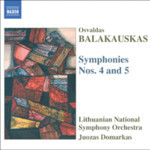
Symphonies Nos. 4 and 5
 $25.00
Out of Stock
$25.00
Out of Stock6+ weeks add to cart
OSVALDAS BALAKAUSKAS
Symphonies Nos. 4 and 5
Igor Kramarev (trumpet) / Romualdas Staskus (oboe) / Lithuanian National Symphony Orchestra / Juozas Domarkas (conductor)
[ Naxos / CD ]
Release Date: Friday 25 November 2005
This item is currently out of stock. It may take 6 or more weeks to obtain from when you place your order as this is a specialist product.
"The playing of the Lithuanian National Symphony Orchestra is first class, having no doubt played the music more than once. I suspect that the composer has had a say in the matter of interpretation. Sonically the issue can't be faulted and with insightful liner notes by Linas Paulauskis and Sarunas Nakas this is a high quality product retailing at super-budget price."
(MusicWeb Jan 2005)
Osvaldas Balakauskas, one of the leading Lithuanian composers, graduated from the Vilnius Pedagogical Institute in 1961, and from Boris Lyatoshinsky's composition class at the Kiev Conservatory in 1969. From 1992 to 1994 he was ambassador of Lithuania, the first after fifty years of foreign rule, to France, Spain, and Portugal. In 1996 Balakauskas was honoured with the Lithuanian National Award, the highest artistic and cultural distinction in Lithuania. He is head of the Composition Department of the Lithuanian Academy of Music and Theatre.
Balakauskas is one of the very few Lithuanian composers who have developed their own unique and precise compositional system. The composer named his technique "dodecatonic": it can be defined as the formation and elaboration of new tonal connection within strict serial structures, along with no less strictly calculated rhythm progressions. Nevertheless, Balakauskas is always able to infuse a certain recognizable stylistic flavour into his mathematically built constructions, which could sound as similar to neoromantic or impressionist music, as to jazz. The synergy of intellect and elegance is what distinguishes his work, as well as steadfast adherence to his own rules of composition, a virtue of being an enthusiastic modernist in the times of ubiquitous post-modernism.
The large list of Balakauskas' compositions is dominated by instrumental genres, chamber ensembles, symphonies, concertos. Symphonic works comprise one of the most important parts of his output, and reveal the composer as a master of instrumentation, skilfully exposing and combining radiant colours of different orchestral groups, emphasizing the individuality and charm of sound of solo instruments. The highlights of Balakauskas's symphonic music include Sonata of the Mountains, inspired by the art of Lithuania's greatest classical composer and painter Mikalojus Konstantinas Ciurlionis (1975); his quasi-minimalist Symphony No. 2, brimming with vigorous rhythms and sparkling colours (1979); Opera Strumentale (1987), an abstract orchestral theatre, with evocative instrumental "arias", "duets" and "choruses"; also the Symphonies No. 4 (1998) and No. 5 (2001), included on this disc. The latter two represent the new direction in Balakauskas's oeuvre; the turning-point was marked by his Requiem in memoriam Stasys Lozoraitis, composed in 1995 [Naxos 8.557604].
Symphony No. 4 was written on the occasion of the start of the new symphonic music season at the Lithuanian National Philharmonic Hall. The titles of its three movements, Octa, Hendeca, Deca, correspond to the composer's invented scales of eight, eleven, and ten tones respectively, which underlie the harmonic material for each movement. It is in fact the harmonic progressions determined by the use of specific scales which often function as melodies or motifs in Balakauskas's music, underpinning the entire musical fabric. As said before, this symphony reflects some trends of the composer's recent creative period, a growing transparency of textures, a neo-classical restraint of expression, a balance of form and emotion. Within his system of scales, the composer now strives to develop a euphonic, consonant sound, as if reverting to the origins and traditions of European music, "to something familiar and recognisable". Among other things, this work also displays discernible signs of jazz, a flexible syncopated rhythm, flowing blues harmonies. Various elements of early and modern music settle smoothly into the homogenous and integral composer's musical vocabulary.
Tracks:
Symphony No. 4
Symphony No. 5
